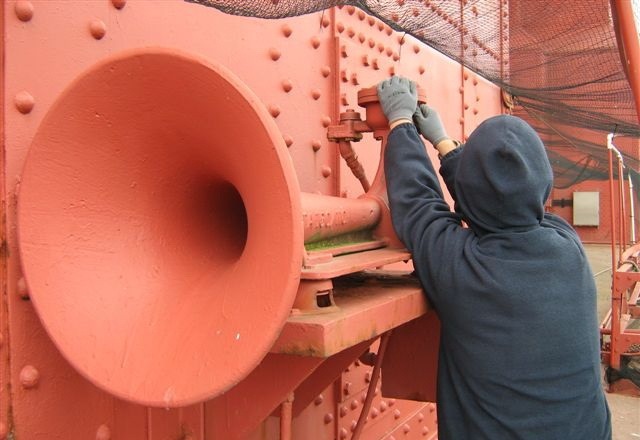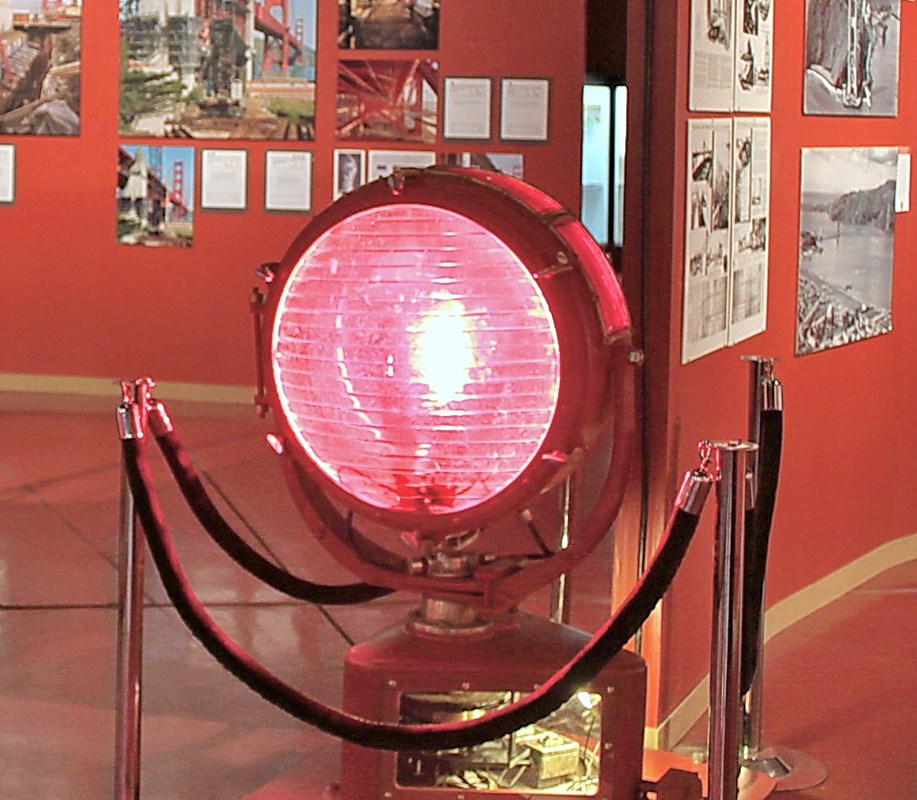Foghorns

The Golden Gate Bridge has an influence in directing fog as it pushes up and pours down around the Bridge. "Advection fog" forms when humid air from the Pacific Ocean swoops over the chilly California current flowing parallel to the coast. The fog hugs the ground and then the warm, moist air condenses as it moves across the bay or land. This is common near any coastline. Sometimes, high pressure squashes it close to the ground. By the way, the color of the Bridge is International Orange and was chosen in part because of its visibility in the fog.
To aid in the safe travel of vessels as they pass under the Golden Gate Bridge, foghorns have been mounted on the Golden Gate Bridge since its opening in 1937. The foghorns are located in two distinct locations: at the middle of the Bridge (mid-span) and at the south (San Francisco) tower pier.
The Golden Gate Bridge foghorns have guided hundreds of thousands of vessels safely through the Golden Gate Strait, and forewarned San Franciscans when fog was rolling in to envelop the City. The foghorns operate about two and a half hours a day on average over a year. During March, you'll hear them for less than half an hour a day; but during the Bay Area's foggy season, which typically occurs during the summer months, they can sound for over five hours a day or for days at a time.
United States Coast Guard, Waterways Management Branch sets the tones and timing pattern of the foghorns. Each foghorn has a different pitch and marine navigational charts give ships the frequency, or signature, of each foghorn.
When the fog rolls in under the Bridge roadway limiting visibility for passing ships, the foghorns are manually turned on (and off) by Bridge workers.
Ship operators heading into the San Francisco Bay steer left of the south (San Francisco) tower pier foghorn and right of the mid-span horn. Outbound vessels stay to the right of the mid-span horn.
Foghorns at Mid-Span
Today, there are three foghorns mounted below the roadway level at mid-span on the Golden Gate Bridge. One faces east and is 24-1/2 inches long and the horn bell is 11-inches in diameter. Two face west and are each 36-inches long with a horn bell that is 18-inches in diameter. The three horns sound as two blasts, each with a distinct tones. The lower of the two tones blasts to the west.
The sequence of the two blasts is this: A 9-second pause starts the sequence and is followed by a 1-second foghorn blast, a 2-second pause, a 1-second blast, a 36-second pause, a 1-second blast, a 2-second pause, a 1-second blast, and a 36-second pause. This pattern continues when the fog horns are on.
In the late 1970's, one of the original 1937 foghorns stopped working when its two air valves gave way and the two-tone horn became a one-tone horn. Since the mechanism was so old, replacement parts were impossible to find. The hobbled horn continued to sound with just one-tone until 1985, when the original foghorns were replaced by new one manufactured by the Leslie Air Horn Company. The new single-tone horns differ in frequency or tone from each other, but operate with compressed air, just like the originals.
Foghorns at the South Tower Pier
There are two foghorns mounted on the south tower pier, about 40 feet above the waterline. One faces east and one faces west. Each horn is 48-inches long with a horn bell that is 23-1/2 inches in diameter.
The two foghorns sound at the same time as a single tone and blast, in this sequence: A 2-second blast, an 18-second pause, a 2-second blast, and an 18-second pause. This pattern continues as long as the horns are turned on.
The foghorns on the south tower pier are one-tone and have a lower sound than the mid-span horns.
Beacons

The Golden Gate Bridge is also equipped with navigational and warning lights for travelers by sea and by air. Originally, a red rotating aircraft beacon shown on the top of each tower. Here is one of the original beacons on display at the 2011 Marin County Fair:
In 1980, the beacons on top of the towers were replaced with 360-degree flashing red beacons. The Bridge main cables are also marked with red cable outline lights. In 1982, they were replaced with new and more efficient lights.
For seafaring vessels, there are red navigation lights on the south pier fender and white and green lights below the deck at mid-span.